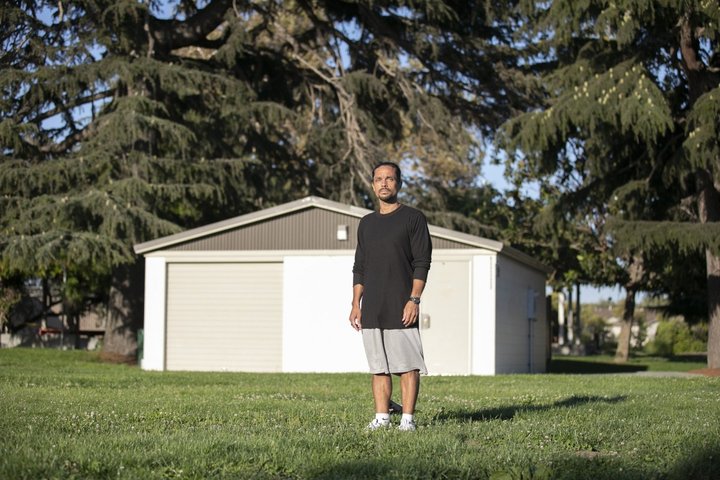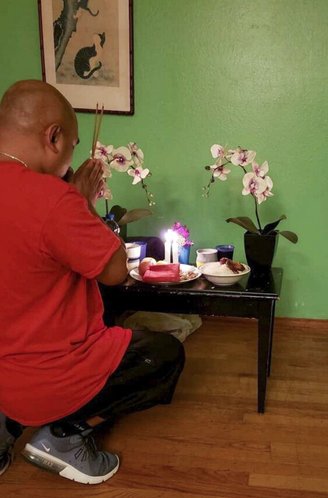
Chris Scull, who was incarcerated at San Quentin for 22 years and released last month, tested positive for COVID-19 in June while in prison. Scull now lives in transitional housing in Hayward and experienced a second lockdown after one of his housemates tested positive for the virus. Photo by Anne Wernikoff for CalMatters.
###
Christopher Scull has vivid memories of early summer at San Quentin State Prison. During the worst of the prison’s coronavirus outbreak, which has infected more than 2,200 inmates, it seemed like the “man down” siren blared every half hour, signaling a medical emergency. The other inmates dropped to the ground while staff rushed by, carrying out a sick prisoner in a wheelchair or on a gurney.
Desperate to control the outbreak at California’s overcrowded prisons, state officials opened the gates to thousands of prisoners like Scull, including many before their scheduled release date.
Scull, who tested positive for the virus in June but had minor symptoms, was released from San Quentin in mid-July after serving 22 years for carjacking and robbery. He said officials expedited his release by several weeks, sending him to a motel in Gardena, south of Los Angeles, to quarantine and recover.
From the start of the pandemic through the end of this month, California will release more than 11,000 prisoners early — largely nonviolent offenders with less than a year to serve — reducing the prison population to a 30-year low.
Overwhelmed by the volume, California’s patchwork reentry system is scrambling to find transportation, housing, food and other services for released prisoners, many of whom were exposed to the virus.
As of this week, the state had released more than 300 inmates known to be infected.
Scull, 42, didn’t have time to finalize his parole plan before he was released.
“It was very chaotic,” Scull said. “All my support team, my employment, everything is in the Bay Area.” But he was taken to the motel in Los Angeles County with little oversight or guidance on what to do. “When I got released, I took it on myself to track down the parole agent,” he said.
While he quarantined in the hotel room, Scull did step out once: “I went to In and Out. Wow, it was great,” he said.
Nonprofits, county probation officials and state officials weren’t prepared to deal with the influx of people released into motels, group homes and the community.
“I had friends out there protesting saying, ‘Let them all out.’ I said, ‘You don’t understand. There’s no system outside that can handle this,’” said Judith Tata, executive director of the California Reentry Program, which provides parole and pre-release services to inmates at San Quentin. “We have people who are transient when they’re arrested. They’re mentally ill, have substance abuse issues and we’re releasing them early to no social services.”
Tata said her program got letters from people in prison asking for help connecting with services on the outside, but by the time they could respond, the men were already out.
The prison outbreak began in late May, when the corrections department transferred sick inmates from the California Institution for Men in Chino to San Quentin and other facilities.
Nearly 9,500 inmates were released from state prisons from July 1 through Aug. 6; almost half were early releases, according to the corrections department.
“We just did not have this infrastructure in place,” said Sam Lewis, executive director of the Anti-Recidivism Coalition, a Los Angeles-based nonprofit. “This happened so fast and the successes have been because many of the community-based organizations have been doing this with their own resources.”
His organization estimates that it costs $650 to transport a single person to a housing facility, including mileage, a meal, protective equipment, clothing and employee wages. Private donors helped pay for it, but more state funding is now becoming available, he said.
“This has been going on forever,” Tata said. “What this pandemic has done is highlight the inadequacies in the system.”
As of this week, nearly 9,000 California prisoners have tested positive for the virus and more than 50 have died, according to the corrections department. The 2,200 infected at San Quentin is equivalent to more than two-thirds of its current population.
Prisons are a uniquely dangerous place for spread of the disease.
U.S. prisoners tested positive at more than five times the rate of the general public, according to a July study co-authored by the UCLA Law COVID-19 Behind Bars Data Project.
“You had people who were sitting ducks,” said Sharon Dolovich, a law professor who runs the data project. “You have lots of vulnerable people who need to get out,” Dolovich said. “Then you have an underfunded and overworked reentry side.”
But ultimately, she said, the state had to stop the outbreak even if it meant difficult days for reentry providers.
“When the house is on fire you get people out,” Dolovich said, repeating a line she heard from a colleague. “You don’t keep someone in a burning house to wait for them to have a place to land.”
“When the house is on fire you get people out.”
— Sharon Dolovich, UCLA Law COVID-19 Behind Bars Data Project
Former inmates from a facility with an outbreak are supposed to quarantine for two weeks, often in a hotel room, before going to transitional housing or into the community.
“For public health reasons, we cannot place anyone who is COVID-19 positive or is identified as being exposed into a reentry program in the community,” Dana Simas, a department spokeswoman, said in an emailed response to questions.
The department relies on nonprofits and community organizations to provide reentry programs and is expanding its contracts with them, Simas said. There’s also state funding for the extra housing needs.
There has been some concern about the possibility that former inmates could spread the virus through communities. But corrections department officials said they can’t force former prisoners to stay in quarantine. “CDCR is not authorized to mandate a quarantine as a special condition of parole because it does not relate to criminal conduct or future criminality,” Simas said.
CalMatters reached out to public health departments in California’s 10 most populous counties about the tracking of former inmates. Half responded and said they had no indication of community spread connected to the releases.
The state since mid-July has been testing all inmates “no more than seven days before their release,” Simas said. “In addition to lab testing, we are also conducting point-of-care rapid response COVID-19 testing before an individual’s release.”
CalMatters spoke to two former prisoners released just before those protocols went into effect. Both said they were not tested within a week before their release.

Chanthon Bun, who was released from San Quentin in July, prays at a small shrine he made to honor two friends who died of COVID-19. Photo courtesy of Chanthon Bun
Chanthon Bun, 41, said he refused to be tested before getting out of San Quentin because he was worried it could delay his release. The testing site was so packed that if he didn’t have the virus he was worried he’d catch it while there.
Bun got out in July on his regular parole date. At the time, he said he had symptoms of the virus for several days, including a fever and chills.
“Everyone in my building in San Quentin had COVID,” Bun said.
Bun, a Cambodian refugee who was worried about getting picked up by federal immigration authorities after his release, said he turned down the offer of a hotel room to quarantine and instead hopped a bus to San Francisco. There he said he met up with advocates and his attorney who took him to get a coronavirus test — he was positive — and then to a Bay Area church where he has been holed up recuperating.
“I really thought I was going to die,” he said. After weeks of 105-degree fevers and trouble breathing, he has finally tested negative.
Another prisoner, James Wortham, who spent 35 years behind bars, said if it wasn’t for the nonprofit California Reentry Institute, he would have been lost after getting out. The institute helped him get a social security card and birth certificate and provided emotional support during the transition.
Wortham, 54, worked in the prison hospital but was only tested for the coronavirus twice, and the last negative test was more than two weeks before he got out in early July. “When I left, they did not test me at all,” he said.
Collette Carroll, executive director and president of the California Reentry Institute, said a parole officer was going to send one man to a reentry house. When she told him that he was COVID-positive, he was sent to quarantine at a hotel instead.
“There’s just so much confusion,” she said.
Local probation departments also are supervising many of the people getting out of prisons. The Los Angeles County Probation Department supervised about 700 new people last month as a result of the prison releases. In Contra Costa County, the Probation Department received 38 expedited releases to supervise since July. The officers have at times had to pick up people from the prisons, possibly exposing the officers to the virus.
In late July, Scull moved to transitional housing in the Bay Area so he could be closer to his substance abuse sponsors, life coaches and employment network.
But his freedom was recently curtailed again, when the house went into quarantine for its own outbreak of the virus. Scull brought a unique perspective to the new shelter-in-place life of a pandemic.
“I’m used to being confined,” he said. “It’s not as big a deal to me.”
###
CALmatters.org is a nonprofit, nonpartisan media venture explaining California policies and politics.
CLICK TO MANAGE